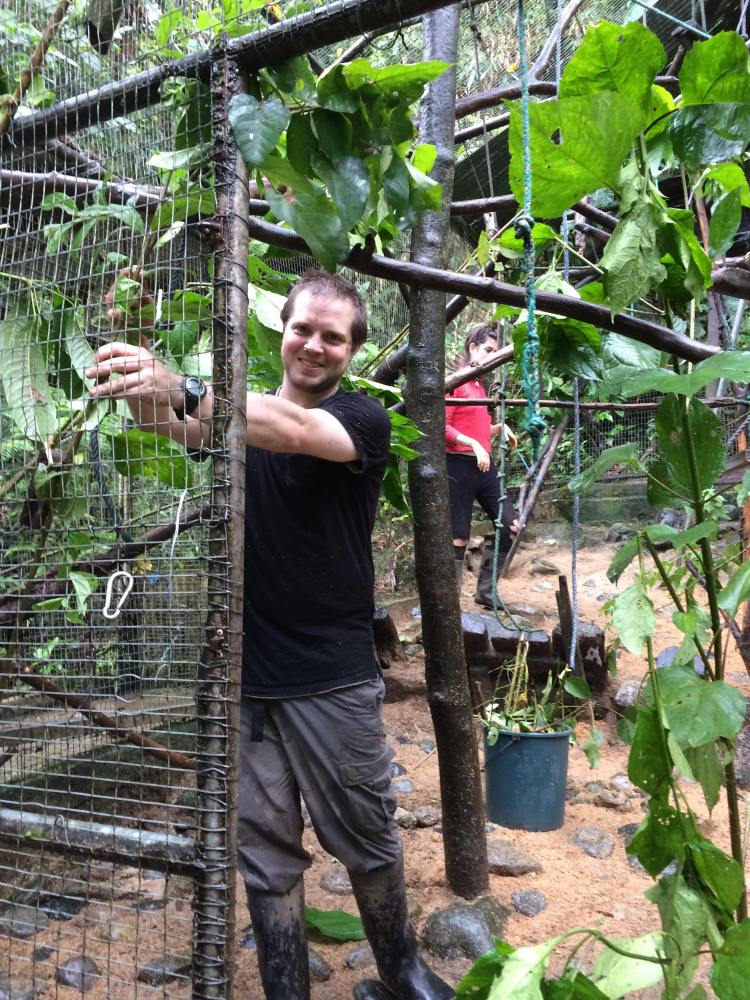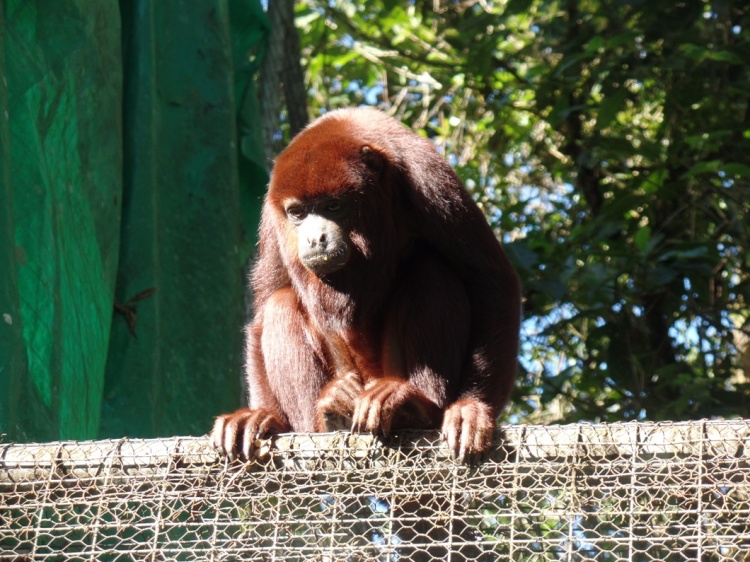28th June – 6th August 2018
Merazonia is a non-profit wildlife rehabilitation centre nestled where the Andes meets the Amazon in Ecuador, and it has been operating for almost a decade. I had the privilege of staying there as a volunteer for a little over five weeks – which is actually not that long in the scheme of things as the minimum stay they ask for is two weeks but almost everyone who comes falls in love with the place and many end up staying for months, even years.

On my first day, I was introduced to everyone, given a tour, and designated a bed in their dormitory. They told me I could spend the afternoon in leisure, having only just arrived, but I was feeling motivated so offered to help them with enrichment activities. A few minutes later, I found myself traipsing through the jungle, towards a release site they were building, and I helped them construct feeders there. Most of Merazonia’s enclosures are just a short walk away from the main headquarters but this was a new one, purposefully built a little further away to help encourage a successful release for primates.

I also met Whistler that night, who would end up being one of my favourites of all the creatures there. Merazonia is primarily a rehabilitation centre and, unlike some places which make such claims, they have a strict policy of minimum human contact for most of their animals because taming them can affect their chances of survival when set free. Their highest priority, however, is wellbeing, and in some cases, where release is not possible, they give them the best life they can.
Whistler is one of those creatures for whom release is not possible. He is a kinkajou; a nocturnal, tree-dwelling mammal that some people mistakenly believe can they can tame and keep as novel pets but end up having a nasty surprise later along the line when the animals reach maturity because detained kinkajous become aggressive out of infancy. Merazonia have been handed many such kinkajous in the past, and most have been successfully released back into the wild, but Whistler, however, is somewhat an oddity. He remains human-orientated, and they suspect he may have brain damage. He also has physical health problems, and one of the daily duties of Merazonia’s volunteers is to visit him at night and give him a spoonful of jam laced with medicine which helps keep him alive. As soon as you enter his cage, he leaps upon you, wraps his tail around your neck, nestles into your arms, and will simply not let you go until he has had a few minutes of attention. They call him Whistler because he once had his nose scratched off by another kinkajou and he makes a strange sound when he breathes. Everyone adores him.

Of course, not all of the work at Merazonia is glamorous. Most of the time you are cleaning cages and it is not something I would recommend to someone with a strong adversity for monkey guano. You have to be quiet while performing these chores and avoid all unnecessary interaction with the animals because it is bad for them to get too used to humans.
That said, volunteering at Merazonia is one of the most rewarding things I have ever done and I learned a lot about wildlife while there. One of my favourite days was when I helped extend the artificial branch system they have for Houdini and Margarita – a pair of macaws who cannot fly and thus roam around Merazonia by climbing along a series of beams – and watching them use it for the first time, knowing that I helped make a pair of creatures worlds’ a little bigger.

During my stay, a lot of attention was focussed upon their group of woolly monkeys. Each one had been brought to the centre individually over the years, and most often they were young, malnourished and traumatised, having just witnessed their mother being hunted for bushmeat and sold as pets to people who didn’t have a clue how to care for them. Each one has had to be nurtured back to health, raised, and introduced to the rest of the group once old enough. It has taken Merazonia years but they finally have a strong enough group to consider preparing for release and I admire the work of its staff and long-term volunteers who have such patience and dedicated their lives to such a cause. I will not be there for the actual release but feel honoured to have been part of the build-up and I hope it goes well.

Merazona also has a group of capuchins which, like the woolly monkeys, need to be fed and have their enclosures cleaned twice a day. They are a little more difficult to manage than woollies because they are highly intelligent and have a complex social structure but, despite how troublesome they can be, they are often amusing to watch and they do put a smile on your face. They have taken in some howler monkeys over the years too, but not so many because unfortunately, not many howlers sold as pets survive long enough to make it to a refuge as they are very specialised feeders and many die of malnutrition. Chiliana is one who was lucky enough to be saved in time, and she has to be taken out into the jungle every day to forage for very particular leaves, learn to climb, and build up her muscles.
There are lots of macaws and other birds, some tamarins, a sloth called Stevie (who is shortly due for release), a puma and, last but not least, Tom the turkey (who has technically been released and is self-sufficient, but spends many of his days roaming around the grounds causing mischief).

Another highlight of my time there was being given the privilege of becoming a ‘Baby Woolly Daddy’ and helping to look after two of Merazonia’s newest members, Fonzi and Chachi, who were adorable and hard to say goodbye to.

Just a little note, so that future volunteers don’t get the wrong idea: Merazonia only lets a limited number of its volunteers handle baby monkeys as, even though it is a necessity for them to have the care and attention their original parents from the wild can no longer give, it is not good for them to be handled by too many people. When Fonzi and Chachi are old enough they will start the rehabilitation process and will likely be the first members of a new group of woollies Merazonia will prepare for release. Who knows? Maybe I will visit Merazonia again in a few years and one of them will be the new alpha male. It would be nice to see them again, but by then the policy of minimum human contact will be in place and I will not be allowed to acknowledge them in the same manner. They will also have become wilder. I will certainly be following Merazonia closely online to hear about their progress.

I have uploaded a few more videos, highlighting some of my favourite moments in Merazonia. You can find them by clicking on the following links:
Visiting the nearby waterfall (I didn’t jump into it myself as I am way too scared of heights!), the woolly monkeys, Chilliana playing in the trees, Fonzi and Chachi montage, and releasing a sloth.
For more photos and videos from Merazonia, click here.
If you are interested in volunteering at Merazonia (or even just helping them out in some other way, such as adopting one of their animals) here is their website. This video on Youtube is also a good introduction to what they are about.

6 thoughts on “Travelblog SA#7: Volunteering at Merazonia – Ecuador”